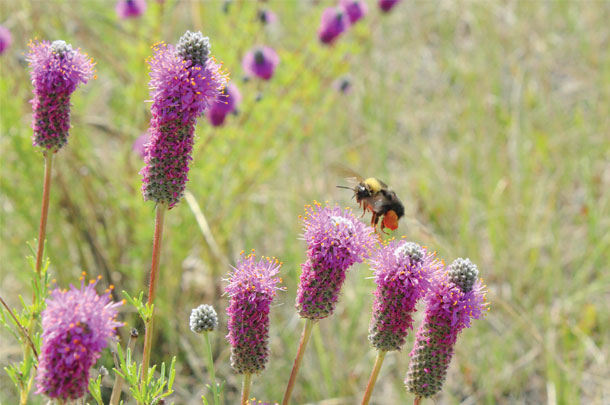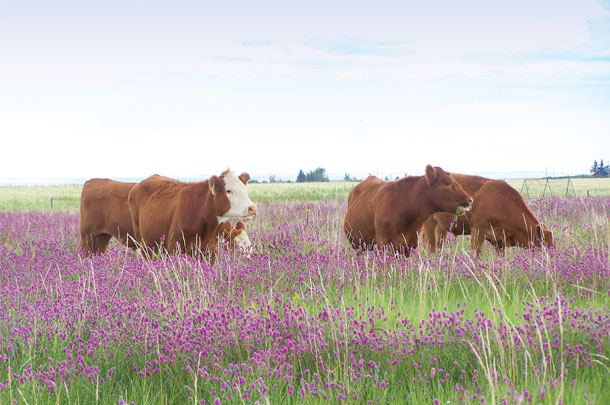Purple prairie clover (PPC, Dalea purpurea Vent.) is an important native perennial legume widely distributed across North America with high palatability, adaptability and forage quality.
It has potential to improve forage productivity and enhance plant and insect biodiversity (Photo 1) of rangelands, and improves soil fertility due to its ability to fix nitrogen. Highly condensed tannin concentrations in PPC tissue improve protein utilization and depresses harmful microbial bacteria (Escherichia coli 0157:H7) in ruminants.
 Purple prairie clover attracts many pollinators and beneficial insects.
Purple prairie clover attracts many pollinators and beneficial insects.
Legumes generally contain more protein and less fiber than grasses at similar stages of growth; thus there has been growing interest in the use of PPC as nutritious forage for both domestic livestock and wildlife and for prairie restoration.
Research on PPC has been conducted by research scientists at Agriculture and Agri-Food Canada – Swift Current Research and Development Center (AAFC-SCRDC) and Lethbridge Research and Development Center (AAFC-LRDC) for over 10 years in the areas of forage and grazing management, ruminant nutrition and microbiology, range ecology and breeding.
Forage characteristics
The PPC is a member of the legume (fabaceae) family. The leaves are fine and alternate, each subdivided into seven to ten small narrow leaflets. The tiny PPC flowers (pinkish-purple) are found at the base of a tightly packed elongated spike at the end of a slender stem that grows about 8 to 20 inches (20 to 50 centimeters) tall.
The PPC plant acts like a warm-season legume, and generally blooms July through September. PPC has the ability to extend and improve the sward forage quality during the entire grazing season and is considered one of the most important legumes in native grasslands on the Great Plains. The adaptation and distribution of PPC is over the entire Great Plains from the Canadian Prairies to Texas.
Initial research on PPC at AAFC-SCRDC occurred with Dr. Alan Iwaasa, a grazing management and ruminant nutrition researcher who conducted a study evaluating the re-establishment of two different native mixes in southern Saskatchewan in 2000.
At that time the only commercially available native legume in sufficient seed quantity and cost effectiveness in western Canada was PPC. From that study to more recent research collaboration studies with AAFC-LRDC, a number of unique forage nutritional and environmental benefits have been identified with PPC.
PPC contains high concentration of condensed tannins that provide varying biological activities, such as anti-microbial, anti-parasital, anti-oxidant and anti-bloating properties. Concentration of extractable condensed tannins is highest at the following physiological maturities stages: flowering, vegetative and seed pod stages, with the highest extractable condensed tannins in the floral and leaf portions of the plant but declines in the stem with increasing maturity.
Researchers concluded that PPC in the vegetative and flower stages provides good-quality forages for ruminants as the fiber and protein contents are similar to other common legumes such as alfalfa and sainfoin harvested at the same growth stages. As expected, at the seedpod stage the PPC forage quality declines with advancing maturity as fiber increases and protein concentration declines.
Seed dispersal
A recent research study by AAFC-SCRDC evaluated the effect of cattle acting as a seed dispersal agent, especially for the dissemination of legumes (Photo 2).
 Yearling steer beef cattle graze purple prairie clover and native grasses in July. Photos provided by Alan Iwaasa.
Yearling steer beef cattle graze purple prairie clover and native grasses in July. Photos provided by Alan Iwaasa.
More legume seeds survive after passing through the digestive system since they are protected from damage by the hard and impermeable seed coat. The cattle digestive system could improve seed germination by scarifying the seed coats. Thus cattle producers are interested in the potential of cattle consuming mature legume forage seeds as a low-cost management practice to reseed pastures.
A study was conducted to evaluate the effect of the cattle digestive system on PPC seed viability and germinability. Results showed the germination percentage of the ingested seeds was two times higher after passing through digestive tracts than the uningested seeds. Over 92% of the PPC seeds survived digestion due to its high hard seed coat rate.
Cattle dispersing PPC seeds with high viability and germinability can be a low-cost method to increase and rejuvenate PPC in pastures during late-season grazing.
In support of this conclusion, another AAFC-SCRDC study evaluating the effects of different grazing systems (deferred rotational grazing versus a continuous grazing system) clearly showed the benefit of late-season grazing on a PPC stand by increasing the frequencies of PPC in the pastures.
The amount of PPC in the deferred rotational grazing was increased by three times over what was found in the continuous grazing system after eight years of grazing. In 2011, the PPC plant frequency ranged from 2.2% to 21.5% in the deferred rotational grazing pastures, while for continuous grazing pastures the range was from 2.9% to 8.4%.
In 2019, the PPC plant frequency improved and ranged from 3.6% to 35.8% in the deferred grazing pastures, while the continuous grazing pastures ranged from 5.9% to 8.9%. The deferred grazing system allows the PPC to set seeds before grazing.
Advantages
Research has shown that PPC can be an important native perennial legume with good palatability and forage quality in North America. The higher-protein content of PPC compared to many cool-season and warm-season grasses throughout the growing season makes the incorporation and increase in PPC frequencies in grassland desirable.
The presence of condensed tannins in PPC contributes additional animal nutritional, health and environmental benefits. PPC’s ability to fix nitrogen, attract pollinators and beneficial insects, and enhance biodiversity are other positive factors that should cause cattle and forage producers to give PPC a second look.










